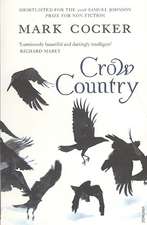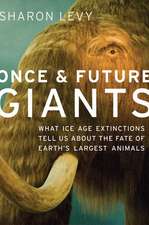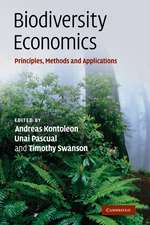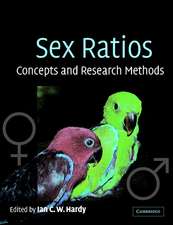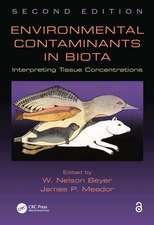Chemical Signals in Vertebrates 12
Editat de Marion L. East, Martin Dehnharden Limba Engleză Hardback – 20 feb 2013
| Toate formatele și edițiile | Preț | Express |
|---|---|---|
| Paperback (1) | 953.52 lei 6-8 săpt. | |
| Springer – 7 feb 2015 | 953.52 lei 6-8 săpt. | |
| Hardback (1) | 959.19 lei 6-8 săpt. | |
| Springer – 20 feb 2013 | 959.19 lei 6-8 săpt. |
Preț: 959.19 lei
Preț vechi: 1169.74 lei
-18% Nou
Puncte Express: 1439
Preț estimativ în valută:
183.56€ • 199.32$ • 154.19£
183.56€ • 199.32$ • 154.19£
Carte tipărită la comandă
Livrare economică 22 aprilie-06 mai
Preluare comenzi: 021 569.72.76
Specificații
ISBN-13: 9781461459262
ISBN-10: 1461459265
Pagini: 484
Ilustrații: XVII, 466 p. 88 illus., 27 illus. in color.
Dimensiuni: 155 x 235 x 31 mm
Greutate: 0.84 kg
Ediția:2013
Editura: Springer
Colecția Springer
Locul publicării:New York, NY, United States
ISBN-10: 1461459265
Pagini: 484
Ilustrații: XVII, 466 p. 88 illus., 27 illus. in color.
Dimensiuni: 155 x 235 x 31 mm
Greutate: 0.84 kg
Ediția:2013
Editura: Springer
Colecția Springer
Locul publicării:New York, NY, United States
Public țintă
GraduateCuprins
Part 1. Olfaction: Receptors and Neural Processing.- 1. Neural Substrate to Associate Odorants and Pheromones: Convergence of Projections from the Main and Accessory Olfactory Bulbs in Mice.- 2. Acceleration of Puberty Onset in Female Mice by Male Urinary Odours: Chemosensory, Physiological and Neuroendocrine Mechanisms.- 3. The Recessus Olfactorius: A Cryptic Olfactory Organ of Anuran Amphibians.- Part 2 Mother-Offspring Communication.- 4. Smell, Suck, Survive: Chemical Signals and Suckling in the Rabbit, Cat and Dog.- 5. Neonatal Recognition in Sheep.- 6. Suckling Odours in Rats and Mice: Biological Substrates that Guide Newborns to the Nipple.- 7. The Role of Olfaction at Birth in Marsupial and Monotreme Mammals.- Part 3. Pheromones and Social Organisation.- 8. Individual Variation in Pheromone Isoform Ratios of the Red-Legged Salamander, Plethodon shermani.- 9. Rodent Urinary Proteins: Genetic Identity Signals and Pheromones.- 10 From Exploration to Selective Information Gathering: The Development of Chemosensory Investigation in Male African Elephants (Loxodonta africana).- Part 4. Odour profiles and social organisation.- 11. Sex Differences in Olfactory Behaviours Reflect the Importance of Scent Marking for Social Integration in Adult Females and Competition between Reproductively Active Males in the Spotted Hyena.- 12. Is the Perception of Dietary Odour Cues Linked to Sexual Selection in Humans?.- 13. Hemiterpenoids and Pyrazines in the Odoriferous Urine of the Maned Wolf (Chrysocyon brachyurus).- 14. The Perfume-Body Odour Complex: An Insightful Model for Culture-Gene Coevolution?.- 15. A Historical Perspective on the Identification of Substances in the Territorial Scent Marks of Male Klipspringer Antelope Oreotragus oreotragus.- 16. Do Urinary Chemosignals Code for Sex, Age, and Season in the Giant Panda, Ailuropoda melanoleuca?.- 17. On the Body Odour of Wild-Caught Mangrove-Marsh Bengal Tiger of Sundarban.- 18. Ultrastructure and Chemical Composition of Elephant Hair in the context of Chemical Signals in the Asian Elephant Elephas maximus.- 19. Methyl Ketone Production in Juvenile Red-sided Garter Snakes.- 20. The Sophistication of Predator Odour Recognition by Minnows.- 21. Adaptive Responses of Embryonic Amphibians to Predation Risk.- 22. Response of Lumholtz’ Tree-Kangaroos (Dendrolagus Lumholtzi) to Odours from Native Arboreal and Introduced Terrestrial Predators – A Preliminary Study.-23. Voles in Space: Effects of Predator Odour on Microtus arvalis Breeding Females, Running title: Effects of predator odour on breeding female voles.- 24. Knowing your Behaviour: The importance of Behavioural Assays in the Characterisation of Chemical Alarm Cues in Fishes and Amphibians.- 25. Avoiding Predation: The Importance of Chemical and Visual Cues in Poison Frog Reproductive Behaviour.- Part 6. Chemical Signals in Birds.- 26. Besides Colours and Songs, Odour is the New Black of Avian Communication.- 27. Intraspecific Olfactory Communication in Zebra Finches (Taeniopygia guttata) – Potential Information Apart from Visual and Acoustic Cues.- 28. Male European Starlings Use Odorous Herbs as Nest Material to Attract Females and Benefit Nestlings.- 29. Embryonic Domestic Chickens can Detect Compounds in an Avian Chemosignal before Breathing Air.- 30. Measurement of 16-androstenes (5a-androst-16-en-3-one, 5a-androst-16-en-3a-ol, 5a-androst-16-en-3b-ol) in Saliva of Landrace and Göttingen Minipig Boars.- 31. The Influence of Experimentally Reduced Vaginal Flora in Oestrus Females on the Mating Behaviour of Male Domestic Dogs (Canis familiaris).- 32. Socio-sexual Stimuli and Reproductive Function: Emerging perspectives of the male effect in sheep and goats.- 33. A Reverse-Engineering Approach to Identifying which Compounds to Bioassay for Signalling Activity in the Scent Marks of African Wild Dogs (Lycaon pictus).- 34. The application of proteomics to the discovery and quantification of proteins in scent signals.
Textul de pe ultima copertă
This volume presents the proceedings of “Chemical Signals in Vertebrates 12”, hosted by the Leibniz Institute for Zoo and Wildlife Research and held between 28th – 31st August, 2011 at the Schloss Friedrichsfelde and the Leibniz Institute for Zoo and Wildlife Research, Berlin, Germany. Chemical Signals in Vertebrates 12 contains the latest research on chemical communication relevant to vertebrates, particularly focusing on new research since the previous meeting in 2006. Topics covered include chemical ecology, biochemistry, behaviour and neurobiology of vertebrates. A broad range of taxonomic groups are discussed, including fish, amphibian, reptiles, birds and mammals including humans. Contributions address a range of topics including new directions in semiochemistry, predator avoidance, olfactory functions including recognition within species, sexual communication and social integration, maternal-offspring communication and applications for conservation.
About the editors:
Dr Marion L. East is a research scientist in the Department of Evolutionary Ecology at the Leibniz Institute for Zoo and Wildlife Research where she heads the Spotted Hyena Research Group. Dr Martin Dehnhard is a research scientist in the Department of Reproduction Biology where he heads the endocrine and the pheromone laboratory.
About the editors:
Dr Marion L. East is a research scientist in the Department of Evolutionary Ecology at the Leibniz Institute for Zoo and Wildlife Research where she heads the Spotted Hyena Research Group. Dr Martin Dehnhard is a research scientist in the Department of Reproduction Biology where he heads the endocrine and the pheromone laboratory.
Caracteristici
Covers a broad range of topics including sexual selection, predator avoidance, migration, mother-offspring communication, social organisation, management of farm animals, olfactory receptors and neural processing
A range of taxonomic groups are discussed, including fish, amphibian, reptiles, birds and mammals including humans
Contains the latest research on chemical communication relevant to vertebrates
A range of taxonomic groups are discussed, including fish, amphibian, reptiles, birds and mammals including humans
Contains the latest research on chemical communication relevant to vertebrates

